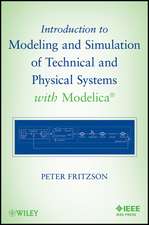Traffic Flow Dynamics: Data, Models and Simulation
Autor Martin Treiber, Arne Kesting Traducere de Christian Thiemannen Limba Engleză Paperback – 9 noi 2014
The main part, after presenting different categories of traffic data, is devoted to a mathematical description of the dynamics of traffic flow, covering macroscopic models which describe traffic in terms of density, as well as microscopic many-particle models in which each particle corresponds to a vehicle and its driver. Focus chapters on traffic instabilities and model calibration/validation present these topics in a novel and systematic way. Finally, the theoretical framework is shown at work in selected applications such as traffic-state and travel-time estimation, intelligent transportation systems, traffic operations management, and a detailed physics-based model for fuel consumption and emissions.
| Toate formatele și edițiile | Preț | Express |
|---|---|---|
| Paperback (1) | 467.43 lei 6-8 săpt. | |
| Springer Berlin, Heidelberg – 9 noi 2014 | 467.43 lei 6-8 săpt. | |
| Hardback (1) | 543.52 lei 6-8 săpt. | |
| Springer Berlin, Heidelberg – 11 oct 2012 | 543.52 lei 6-8 săpt. |
Preț: 467.43 lei
Nou
Puncte Express: 701
Preț estimativ în valută:
89.45€ • 97.13$ • 75.14£
89.45€ • 97.13$ • 75.14£
Carte tipărită la comandă
Livrare economică 22 aprilie-06 mai
Preluare comenzi: 021 569.72.76
Specificații
ISBN-13: 9783642447969
ISBN-10: 3642447961
Pagini: 520
Ilustrații: XIV, 506 p.
Dimensiuni: 155 x 235 x 27 mm
Greutate: 0.72 kg
Ediția:2013
Editura: Springer Berlin, Heidelberg
Colecția Springer
Locul publicării:Berlin, Heidelberg, Germany
ISBN-10: 3642447961
Pagini: 520
Ilustrații: XIV, 506 p.
Dimensiuni: 155 x 235 x 27 mm
Greutate: 0.72 kg
Ediția:2013
Editura: Springer Berlin, Heidelberg
Colecția Springer
Locul publicării:Berlin, Heidelberg, Germany
Public țintă
Upper undergraduateCuprins
Introduction.- Part I Traffic Data: Trajectroy and Floating-Car Data.- Cross-Sectional Data.- Representations of Cross-Sectional Data.- Spatiotemporal Reconstruction of the Traffic State.- Part II Traffic Flow Modeling: General Aspects.- Continuity Equation.- The Lighthill-Whitham-Richards Model.- Macroscopic Models with Dynamic Velocity.- Elementary Car-Following Models.- Car-Following Models based on Driving Strategies.- Modeling Human Aspects of Driving Behavior.- Cellular Automata.- Lane-Changing and other Discrete-Choice Situations.- Stability Analysis.- Calibration and Validation.- The Phase Diagram of Congested Traffic States.- Part III Applications of Traffic Flow Theory: Traffic Flow Breakdown and Traffic-State Recognition.- Travel Time Estimation.- Fuel Consumption and Emissions.- Model-Based Traffic-Flow Optimization.- Solutions to the Problems.
Recenzii
“The contents of the book are exactly as its title suggests, written by authors currently working at the forefront of traffic flow dynamics research and development. … I recommend Traffic Flow Dynamics: Data, Models and Simulation as a very thorough textbook and reference for those in the transportation sciences field. I especially appreciate the long lists of references and recommended readings as well as the companion, open-source, traffic simulation software, videos and examples.” (Jon W. Mooney, Noise Control Engineering Journal, Vol. 65 (2), March-April, 2017)
“Traffic Flow Dynamics is divided into three parts. The first part is devoted to discussing highway traffic data. … In the second part of the book, the authors describe almost all the important achievements in the field … . The final part of the book applies traffic-flow theory to solving traffic jams … . it will be a useful guide for students who want to make the jump into a fascinating area of research.” (Katsuhiro Nishinari, Physics Today, March, 2014)
“Traffic Flow Dynamics is divided into three parts. The first part is devoted to discussing highway traffic data. … In the second part of the book, the authors describe almost all the important achievements in the field … . The final part of the book applies traffic-flow theory to solving traffic jams … . it will be a useful guide for students who want to make the jump into a fascinating area of research.” (Katsuhiro Nishinari, Physics Today, March, 2014)
Notă biografică
Martin Treiber received his diploma (M.Sc.) and doctoral (Ph.D.) degree in physics in 1996 from the University in Bayreuth, Germany. He is a lecturer at the Chair for Traffic Modeling and Econometrics at the University of Technology in Dresden, Germany and runs the web-site www.traffic-simulation.de. His research interests include vehicular traffic dynamics and modeling, traffic data analysis and state estimation, and the study of macroeconomic impacts of motorized individual traffic.
Arne Kesting received his diploma (M.Sc.) in physics in 2002 from the Free University of Berlin, Germany, and a doctoral (Ph.D.) degree in 2008 from the University of Technology in Dresden, Germany. In 2009, he received the IEEE ITS Best Ph.D. Dissertation Award for the thesis "Microscopic Modeling of Human and Automated Driving: Towards Traffic-Adaptive Cruise Control". His research interests include microscopic traffic simulation, advanced driver-assistant systems, and car-to-car communication.
Arne Kesting received his diploma (M.Sc.) in physics in 2002 from the Free University of Berlin, Germany, and a doctoral (Ph.D.) degree in 2008 from the University of Technology in Dresden, Germany. In 2009, he received the IEEE ITS Best Ph.D. Dissertation Award for the thesis "Microscopic Modeling of Human and Automated Driving: Towards Traffic-Adaptive Cruise Control". His research interests include microscopic traffic simulation, advanced driver-assistant systems, and car-to-car communication.
Textul de pe ultima copertă
This textbook provides a comprehensive and instructive coverage of vehicular traffic flow dynamics and modeling. It makes this fascinating interdisciplinary topic, which to date was only documented in parts by specialized monographs, accessible to a broad readership. Numerous figures and problems with solutions help the reader to quickly understand and practice the presented concepts. This book is targeted at students of physics and traffic engineering and, more generally, also at students and professionals in computer science, mathematics, and interdisciplinary topics. It also offers material for project work in programming and simulation at college and university level.
The main part, after presenting different categories of traffic data, is devoted to a mathematical description of the dynamics of traffic flow, covering macroscopic models which describe traffic in terms of density, as well as microscopic many-particle models in which each particle corresponds to a vehicle and its driver. Focus chapters on traffic instabilities and model calibration/validation present these topics in a novel and systematic way. Finally, the theoretical framework is shown at work in selected applications such as traffic-state and travel-time estimation, intelligent transportation systems, traffic operations management, and a detailed physics-based model for fuel consumption and emissions.
The main part, after presenting different categories of traffic data, is devoted to a mathematical description of the dynamics of traffic flow, covering macroscopic models which describe traffic in terms of density, as well as microscopic many-particle models in which each particle corresponds to a vehicle and its driver. Focus chapters on traffic instabilities and model calibration/validation present these topics in a novel and systematic way. Finally, the theoretical framework is shown at work in selected applications such as traffic-state and travel-time estimation, intelligent transportation systems, traffic operations management, and a detailed physics-based model for fuel consumption and emissions.
Caracteristici
First comprehensive textbook of this fascinating interdisciplinary topic which explains advances in a way that it is easily accessible to engineering, physics and math students Presents practical applications of traffic theory such as driving behavior, stability analysis, stop-and-go waves, and travel time estimation Presents the topic in a novel and systematic way by addressing both microscopic and macroscopic models with a focus on traffic instabilities Revised and extended edition of the German textbook "Verkehrsdynamik und -simulation" Includes supplementary material: sn.pub/extras













